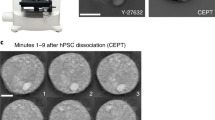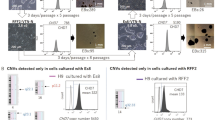Abstract
The protocols described here address methods used in two crucial stages in the retroviral reprogramming of somatic cells to produce human induced pluripotent stem cell (hiPSC) lines. The first is an optimized method for producing lentivirus at an efficiency 600-fold greater than previously published, and it includes conjugation of the lentivirus to streptavidin superparamagnetic particles; this process takes 8 d. The second method enables the isolation of true hiPSCs immediately after somatic cell reprogramming and involves column-based positive selection of cells expressing the pluripotency marker TRA-1-81. This process takes 2 h and, as it is directly compatible with feeder-free culture, the time burden of manually identifying and mechanically propagating hiPSC colonies is reduced drastically. Taken together, these methods accelerate the production of hiPSCs and enable lines to be isolated, expanded to ∼107 cells and cryopreserved within 6–8 weeks.
This is a preview of subscription content, access via your institution
Access options
Subscribe to this journal
Receive 12 print issues and online access
$259.00 per year
only $21.58 per issue
Buy this article
- Purchase on Springer Link
- Instant access to full article PDF
Prices may be subject to local taxes which are calculated during checkout



Similar content being viewed by others
References
Park, I.H., Lerou, P.H., Zhao, R., Huo, H. & Daley, G.Q. Generation of human-induced pluripotent stem cells. Nat. Protoc. 3, 1180–1186 (2008).
Dick, E.P. et al. Two new protocols to enhance the production and isolation of human induced pluripotent stem cell lines. Stem Cell Res. 6, 158–167 (2011).
Yu, J. et al. Induced pluripotent stem cell lines derived from human somatic cells. Science 318, 1917–1920 (2007).
Takahashi, K. et al. Induction of pluripotent stem cells from adult human fibroblasts by defined factors. Cell 131, 861–872 (2007).
Kaji, K. et al. Virus-free induction of pluripotency and subsequent excision of reprogramming factors. Nature 458, 771–775 (2009).
Woltjen, K. et al. piggyBac transposition reprograms fibroblasts to induced pluripotent stem cells. Nature 458, 766–770 (2009).
Zhou, W. & Freed, C.R. Adenoviral gene delivery can reprogram human fibroblasts to induced pluripotent stem cells. Stem Cells 27, 2667–2674 (2009).
Stadtfeld, M., Nagaya, M., Utikal, J., Weir, G. & Hochedlinger, K. Induced pluripotent stem cells generated without viral integration. Science 322, 945–949 (2008).
Kim, D. et al. Generation of human induced pluripotent stem cells by direct delivery of reprogramming proteins. Cell Stem Cell 4, 472–476 (2009).
Zhou, H. et al. Generation of induced pluripotent stem cells using recombinant proteins. Cell Stem Cell 4, 381–384 (2009).
Warren, L. et al. Highly efficient reprogramming to pluripotency and directed differentiation of human cells with synthetic modified mRNA. Cell Stem Cell 7, 618–630 (2010).
Okita, K., Nakagawa, M., Hyenjong, H., Ichisaka, T. & Yamanaka, S. Generation of mouse induced pluripotent stem cells without viral vectors. Science 322, 949–953 (2008).
Stadtfeld, M. & Hochedlinger, K. Induced pluripotency: history, mechanisms, and applications. Genes Dev 24, 2239–2263 (2010).
Brambrink, T. et al. Sequential expression of pluripotency markers during direct reprogramming of mouse somatic cells. Cell Stem Cell 2, 151–159 (2008).
Takahashi, K. & Yamanaka, S. Induction of pluripotent stem cells from mouse embryonic and adult fibroblast cultures by defined factors. Cell 126, 663–676 (2006).
Chan, E.M. et al. Live cell imaging distinguishes bona fide human iPS cells from partially reprogrammed cells. Nat. Biotechnol. 27, 1033–1037 (2009).
Merten, O.W. State-of-the-art of the production of retroviral vectors. J. Gene Med. 6 (Suppl 1): S105–S124 (2004).
Carmo, M. et al. Thermosensitivity of the reverse transcription process as an inactivation mechanism of lentiviral vectors. Hum. Gene Ther. 20, 1168–1176 (2009).
Carmo, M., Panet, A., Carrondo, M.J., Alves, P.M. & Cruz, P.E. From retroviral vector production to gene transfer: spontaneous inactivation is caused by loss of reverse transcription capacity. J. Gene Med. 10, 383–391 (2008).
Chilton, J.M. & Le Doux, J.M. Quantitative analysis of retroviral and lentiviral gene transfer to murine embryonic stem cells. J. Biotechnol. 138, 42–51 (2008).
Higashikawa, F. & Chang, L. Kinetic analyses of stability of simple and complex retroviral vectors. Virology 280, 124–131 (2001).
Zufferey, R. et al. Self-inactivating lentivirus vector for safe and efficient in vivo gene delivery. J. Virol. 72, 9873–9880 (1998).
Nesbeth, D. et al. Metabolic biotinylation of lentiviral pseudotypes for scalable paramagnetic microparticle-dependent manipulation. Mol. Ther. 13, 814–822 (2006).
Chan, L. et al. Conjugation of lentivirus to paramagnetic particles via nonviral proteins allows efficient concentration and infection of primary acute myeloid leukemia cells. J. Virol. 79, 13190–13194 (2005).
Logan, A.C. et al. Factors influencing the titer and infectivity of lentiviral vectors. Hum. Gene Ther. 15, 976–988 (2004).
Miltenyi, S., Muller, W., Weichel, W. & Radbruch, A. High gradient magnetic cell separation with MACS. Cytometry 11, 231–238 (1990).
Grutzkau, A. & Radbruch, A. Small but mighty: how the MACS-technology based on nanosized superparamagnetic particles has helped to analyze the immune system within the last 20 years. Cytometry A 77, 643–647 (2010).
Braam, S.R. et al. Improved genetic manipulation of human embryonic stem cells. Nat. Methods 5, 389–392 (2008).
Watanabe, K. et al. A ROCK inhibitor permits survival of dissociated human embryonic stem cells. Nat. Biotechnol. 25, 681–686 (2007).
Baup, D. et al. Variegation and silencing in a lentiviral-based murine transgenic model. Transgenic Res. 19, 399–414 (2010).
Smith, J.R. & Whitney, R.G. Intraclonal variation in proliferative potential of human diploid fibroblasts: stochastic mechanism for cellular aging. Science 207, 82–84 (1980).
Stojkovic, P. et al. An autogeneic feeder cell system that efficiently supports growth of undifferentiated human embryonic stem cells. Stem Cells 23, 306–314 (2005).
Park, I.H. et al. Reprogramming of human somatic cells to pluripotency with defined factors. Nature 451, 141–146 (2008).
Burridge, P.W. et al. Improved human embryonic stem cell embryoid body homogeneity and cardiomyocyte differentiation from a novel V-96 plate aggregation system highlights interline variability. Stem Cells 25, 929–938 (2007).
Bendall, S.C. et al. IGF and FGF cooperatively establish the regulatory stem cell niche of pluripotent human cells in vitro. Nature 448, 1015–1021 (2007).
Priddle, H. et al. Bioluminescence imaging of human embryonic stem cells transplanted in vivo in murine and chick models. Cloning Stem Cells 11, 259–267 (2009).
Acknowledgements
This work was supported by the Medical Research Council, the Biotechnology and Biological Sciences Research Council and the British Heart Foundation. We would like to thank our collaborators at the University of Newcastle International Centre for Life who provided fibroblast samples from the BioBank in Newcastle, which is part of the MRC centre for Neuromuscular Diseases and EuroBioBank.
Author information
Authors and Affiliations
Contributions
E.D. designed the experiments, carried out the work, analyzed the results and prepared the manuscript. E.M. derived the HUES-Fib line used for control experiments. L.E.Y. was involved in hiPSC setup. D.D. derived the modified 293T line, BL15, and provided methods for the calcium precipitation of lentiviral supernatants. C.D. is the principal investigator on the project and coordinates research activity and funding.
Corresponding author
Ethics declarations
Competing interests
The authors declare no competing financial interests.
Rights and permissions
About this article
Cite this article
Dick, E., Matsa, E., Young, L. et al. Faster generation of hiPSCs by coupling high-titer lentivirus and column-based positive selection. Nat Protoc 6, 701–714 (2011). https://doi.org/10.1038/nprot.2011.320
Published:
Issue Date:
DOI: https://doi.org/10.1038/nprot.2011.320
This article is cited by
-
Mesenchymal stromal/stem cell separation methods: concise review
Cell and Tissue Banking (2017)
-
An Experimental Approach to the Generation of Human Embryonic Stem Cells Equivalents
Molecular Biotechnology (2014)
-
Generation of human induced pluripotent stem cells from urine samples
Nature Protocols (2012)
Comments
By submitting a comment you agree to abide by our Terms and Community Guidelines. If you find something abusive or that does not comply with our terms or guidelines please flag it as inappropriate.



